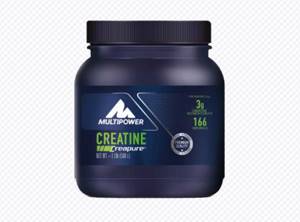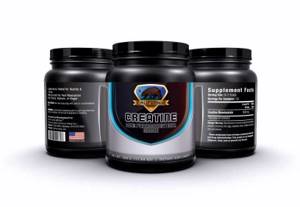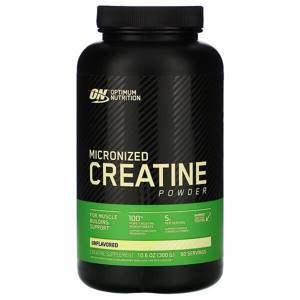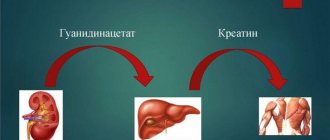Description of glutamine and its actions
Glutamine is an amino acid necessary for muscle growth. This is the main component of protein. For the body of people involved in sports, this supplement is necessary to stimulate the functioning of the immune system. The amino acid accumulates in muscle cells.
The substance is found in foods such as cabbage, fish, beef, eggs, sugar beets, spinach and dairy products.
Benefits for the body:
- restoration of immunity;
- accelerating the recovery process after training and competitions;
- energy replenishment;
- suppression of dissimilation;
- preventing fatigue;
- balanced glucose levels;
- growth stimulation;
- improving body parameters

The drug does not cause side effects and has no age restrictions.
Protein
Low protein intake or minimal intake of it into the body leads to a decrease and destruction of muscle mass. Muscles are made of protein, so they need additional protein and must be fueled in a timely manner, stimulating the restoration of damaged muscle fibers after physical activity, to increase muscle strength and endurance. Muscle fibers that have been damaged during exercise due to heavy workload, physical stress, and catabolic hormones need renewal and accelerated protein synthesis. Protein is also needed to create new contractile proteins to increase muscle strength. According to a 1995 study in the International Journal of Sports Nutrition, athletes need 1.2 to 1.8 grams of protein per kilogram of body weight per day to stay in shape and recover well after hard, intense training.
Description of creatine and its actions
Creatine participates in the body's metabolic processes (energy exchange in nerve and muscle fibers). It is responsible for supplying the muscles with energy during periods of active exercise. Taking the supplement increases the level of phosphocreatine, which promotes speedy recovery and increased muscle endurance.

The substance gives:
- Increase in strength data.
- Multiplication of muscle mass.
- Increases stamina.
- Has a beneficial effect on the recovery process after exercise.
- Improves body contour and muscle quality.
- Blocks the reproduction of lactic acid.
It increases activity and helps eliminate depression. Has a beneficial effect on the nervous system. Supplements are in demand by all athletes, but most athletes are vegetarians. Supplements fully provide the body with the necessary substances, in a way that they do not receive it from food. Thanks to this, if used correctly, it is possible to lose extra pounds.

Effects of glutamine use and research
In many sources you can see the same described effects from taking glutamine:
- Participates in the synthesis of muscle proteins (although its effect on muscle gain has not been proven);
- It is a source of energy in the body, along with glucose;
- Suppresses the secretion of cortisol (anti-catabolic effect);
- Strengthens the immune system;
- Prevents the development of overtraining;
- Affects the process of glycogen accumulation;
- Is an anti-stress factor;
- Promotes the transmission of impulses to muscles;
- Improves brain activity;
But should we take these conclusions at face value? What do scientific studies say about this?
Here is the conclusion from Wikinson's research:
“As an experiment in two groups of subjects showed, adding glutamine to food does not affect the rate of muscle protein synthesis after exercise. A mixture of carbohydrates and glutamine did not accelerate glycogen resynthesis (recovery) after exercise, but did reduce the rate of muscle breakdown (catabolism).”
Conclusion: Glutamine supplementation probably does not help protein synthesis, but does reduce muscle breakdown (anti-catabolic effect).
The following two studies suggest that glutamine has no effect on strength and volume in bodybuilders:
“Glutamine supplementation during strength training has no effect on performance, muscle growth, or protein synthesis rates in young healthy athletes.”
“Glutamine does not affect the strength performance of athletes, because There were no differences in strength when performing the bench press and leg press in the control and placebo groups."
Conclusion: Glutamine most likely does not affect strength, muscle growth, or protein synthesis.
Here is another conclusion from another study:
“Although glutamine supplementation was directly associated with an increase in this amino acid in the blood, its effect on overtraining and immunity was not identified.”
Conclusion: The effect of glutamine on increasing the body's resistance to diseases and improving recovery abilities is ambiguous.
So, what about glutamine?
It would seem that glutamine does not have any benefit, BUT, why then are most professional athletes inclined to say that this supplement really works?
The second thing that raises doubts is the EXISTENCE TIME OF GLUTAMINE ON THE SPORTS NUTRITION MARKET! Glutamine was used in high dosages by athletes of the 60s and 70s, i.e. it “has stood the test of time.”
As a rule, supplements that do not work at all or that work very poorly disappear from the shelves of sports nutrition stores after 1-2 years of appearing on the market (as supposedly a milder analogue of steroids - “Ecdisten” or “Ecdysterone”). But glutamine is still sold and very successfully! What's the matter?
But the point, in my opinion, is that theory can be very different from practice.
Based on research from the University of Oxford involving ultramarathons and marathon runners, it was found that:
“Glutamine supplements taken immediately after running and again 2 hours later are likely to reduce the risk of infection and improve immunity. In the week following the marathon, only 19% of runners taking glutamine became ill, compared with 51% of those taking placebo."
What else will be of great interest to runners? And the fact that it was found that SLOW MUSCLE FIBERS (SMF) HAVE THREE TIMES MORE GLUTAMINE THAN FAST FIBERS (FMF)! Here is my article about muscle fiber types.
Based on another study, it was found that glutamine is an additional source of energy during training, because. many amino acids can be converted first to glutamine and then to alanine.
Alanine is first converted into glucose in the liver, and then returned to the muscles! Thus, glutamine can provide up to 10% of energy, depending on glycogen levels, training intensity and energy intake.
Well, here’s another very interesting study:
“The need for glutamine increases greatly during stressful conditions such as trauma, surgery, burns and other tissue damage, as well as physical activity. In these cases, the glutamine actually produced by the body becomes insufficient.”
There have been many studies using glutamine in people with various degrees of burns, as well as in other situations where people have lost a lot of protein, and it was found that the administration of this amino acid (usually through an IV) significantly slows catabolism.
As you can see, everything is ambiguous! Some studies say one thing, others say another. What should you do in this case? BASE ON PRACTICE!
Rules for joint reception
Experts recommend taking approximately 10 grams of glutamine per day. This dosage is divided into 5 milligrams into two doses.

For example, taking after exercise and at night:
- at the end of training, a process of suppression of muscle growth and catabolic hormones is necessary;
- Before going to bed, the production of night-time growth hormone increases. During periods when there is no training, it should be consumed at lunch and at night;
- Creatine is taken before training and 5 milligrams each. On a free day, reception is morning and evening;
Joint use is necessary for full effect, since glutamine transports creatine, the required effect is achieved.
Is glutamine an essential supplement or a useless one?
You've probably heard about the sports supplement glutamine, but most likely you've never tried to include it in your sports nutrition kit. Think you don't need glutamine? Perhaps this is true, perhaps not...
Once upon a time there were two sisters - creatine and glutamine. Creatine is hot—there's no doubt about it. She looks great - a beautiful tan, long legs, shod in sandals. Yes, Creatine made people turn heads wherever she appeared. She even made it onto the covers of popular magazines!
Glutamine, on the contrary, is reserved, wears glasses, braces on her teeth, and rarely lets her hair down. Of course, it doesn't get as much attention as Creatine. But that didn't seem to bother her, even when the guys "pushed her aside" in favor of hanging out with Creatine a little more.
But if you take off Glutamine's glasses, her braces, and let her hair flow, you'll see a very sexy thing. Yes, plus she's smart and has a big bank account. A complete set, what can I say!
"I think it's time to take a closer look at Glutamine"!
Why do I need glutamine?
Glutamine is one of those substances that doesn't get the attention it deserves. Unfortunately, it turned out to be pushed into the shadows by brighter products like creatine, growth hormone, and prohormones. In the highly competitive sports supplement industry, manufacturers are racing to bring the newest, best, edge-providing supplements to the shelves.
People are usually shocked that I classify glutamine as an “essential supplement” (essential supplements are those that I can’t live without). In my opinion, glutamine ranks in the same place as whey protein, meal replacement powders (MRP's), and essential fatty acids. Yes, that's right, boys and girls, I put glutamine ahead of creatine in terms of importance.
.
Shocked? Believe me, you are not the first... Please note
Rocket Nutrition 's BCAA Aminoblast product with Cola and Mojito flavors! Over 3 grams of glutamine per serving, plus a high dose of BCAA and citrulline!
Order right now on our website with delivery throughout Russia and Belarus!
Now, glutamine doesn't have pages and pages of hype about how it will increase muscle mass by 200% or even 300%, but it does lay the foundation for a solid foundation for athletes and everyday people alike. Glutamine can increase the release of growth hormone, reduce muscle pain, speed up recovery
, help your body in times of stress, help stimulate protein synthesis, increase muscle size, provide support for the immune system, and help a huge number of internal organs.
Plasma glutamine levels are an indicator in determining Overtraining Syndrome (OTS), and glutamine may help prevent this syndrome. Moreover, glutamine assists in the production of glutathione , one of the most powerful antioxidants in the human body. Like I said, glutamine is a sexy little thing.
What is glutamine?
Glutamine is one of the many amino acids that make up protein. In the human body, the proportion of glutamine among free amino acids is more than 60 percent, making glutamine the leading amino acid. Glutamine was originally classified as a nonessential amino acid because it could be synthesized from other amino acids - glutamine amino acid, isoleucine and valine.
However, glutamine has recently been relegated to the category of “conditionally essential” amino acids because the human body cannot always produce as much glutamine as required.
. I believe both of these labels are wrong.
When something is declared to be “not essential,” people too often begin to think that it is unnecessary, unnecessary, or unimportant. I believe that glutamine is both important and necessary. The bulk of glutamine is produced and stored in skeletal muscle and lungs. Glutamine is sold in powder or capsule form. The powder I prefer is white and fluffy, like the stuff you see at Hollywood parties (just don't try snorting glutamine). The aroma is sweetish, the taste is not tasty, although sports nutrition manufacturers will not let you feel it by adding tasty flavors.
Why would someone need more glutamine than their body can produce?
Exercise or everyday stress (like almost getting caught with your boss's spouse...at the boss's desk) can deplete glutamine stores. Sick people, people in critical condition, burn patients, and postoperative patients also require additional doses of glutamine. When the body is stressed or injured, it begins to absorb glutamine from stores found in skeletal muscle.
In an attempt to heal itself, the body sends accumulated glutamine into damaged tissue. When glutamine stores are depleted, the ability to repair damaged tissue is reduced. Catabolic stress associated with stress or injury can reduce glutamine levels by more than 50%. This greatly expands the list of those who need additional glutamine, anyone who exercises, is exposed to everyday stress, is injured, is sick will benefit from additional glutamine. So if your boss caught you, you may need glutamine as an anti-stress or post-surgery remedy.
Are you overtraining?
“I work out five days a week, trying to make my butt smaller, and I’m not getting any results. But that's not all, I'm constantly sick, I'm irritable, my ass wiggles a meter behind me when I walk. I don't think I can train any more, but I want to see some results. What am I doing wrong?"
This was a question I was asked recently, would anyone say this is overtraining? Sometimes daily slaps aren't enough to wake someone up. There are many situations in life in which more is not better (of course, it often happens that more is better).
Often, overtraining, as measured by plasma glutamine levels, results from training volumes or intensities that are greater than what is acceptable given the recovery time available. If you don't give the body a chance to recover sufficiently between workouts, the body can't adequately repair itself, and the result is overtraining. Overtraining is responsible for decreased physical activity, problems with immunity, inactivity, and irritability. The most annoying thing is that if you have overtraining, only time, rest, nutrition, and supplements can help. Unfortunately, it takes much longer to recover than it does to “get” overtraining.
Many athletes are in a state of overtraining for 6 months straight. In a recent study, scientists observed seven athletes who ran a long distance for 10 days in a row. According to scientists, even after 6 days allotted for recovery, some athletes had low levels of glutamine in the blood plasma.
In the same study, researchers found that after athletes performed only one training session of short sprints, plasma glutamine levels dropped by 45%. As you can see, plasma glutamine levels can drop very easily, and they can stay low for quite a long time.
I believe that glutamine supplementation is a smart way to maintain skeletal muscle glutamine stores as well as maintain plasma glutamine levels. Maintaining glutamine stores and plasma glutamine levels can be a very effective way to limit the possibility of overtraining. The ancients said: “An ounce of prevention is worth a pound of cure.” It couldn’t be truer.
What about growth hormone?
Growth hormone, produced by the pituitary gland, is a very complex hormone consisting of 191 amino acids. An increase in lean body mass, a decrease in body fat, an increase in sexual attractiveness, mood, memory, alertness - all this is associated with growth hormone. Unfortunately, after age 30, the body begins to produce less growth hormone
, and its secretion decreases with age.
Due to the decrease in the secretion of growth hormone, we should expect a reverse manifestation of the above-described qualities. If we can prevent and reverse the decline in growth hormone secretion, we can add a little spring to our walk, a little firmness to our pen movement, and a little more yo to our yohoo. It is very possible that growth hormone is the very fountain of youth.
There are two ways to increase growth hormone secretion: use recombinant growth hormone (synthesized in laboratories and given as an injection), or stimulate the pituitary gland to increase hormone secretion naturally. Synthetic growth hormone therapy costs more than $20,000 per year and is not covered by health insurance in most cases.
For most, synthetic growth hormone is unaffordable due to financial reasons. On the other hand, using products that stimulate the pituitary gland, you can increase the secretion of growth hormone in a fairly economical way.
Glutamine is a proven supplement that significantly increases plasma levels of growth hormone
. Within 45 minutes of eating a light breakfast, nine participants received a two-gram serving of glutamine. After just 30 minutes, plasma levels of growth hormone increased by 430% and returned to normal levels after 90 minutes. Considering the volume of discoveries regarding increasing growth hormone levels, this study is very encouraging.
If you are interested in an inexpensive way to increase plasma levels of growth hormone, you can take two to 5 grams of glutamine at a time, 5 to 6 times a day between meals. Growth hormone usually enters the bloodstream shortly after falling asleep, so make sure that your last glutamine intake is shortly before bedtime.
How to use glutamine correctly?
Answering the question of how much glutamine you should consume is quite difficult. There is no one standard answer that fits every case. When determining the dose of glutamine, body weight, activity level, level of daily stress, general health, and diet are taken into account. You also need to consider the purpose for which you are using glutamine. Preventing overtraining, stimulating growth hormone production, aiding the immune system, or simply replacing sugar in your post-workout mixture?
If it is to prevent overtraining, then I recommend consuming glutamine before and after training, as well as before bed. Again, there are too many variables to consider to give you an accurate answer on exactly how much to consume. Basically - 4-10 grams before and after training, as well as before bed. If you're on a low-carb diet, you may want to increase this amount, especially in your post-workout blend. Glutamine increases glycogen stores by 16% when taken after a workout.
I have seen recommendations to consume 1 gram of glutamine per kilogram of body weight. Taking large doses of glutamine half an hour before your workout will provide you with an unforgettable experience. After experimenting with 30 grams of glutamine pre-workout, I experienced such an increase in muscle mass that I could no longer strain my muscles.
No supplement, including creatine, has given such a “pump” before!
However, I must warn you: someone has told me that they feel nauseous after consuming large amounts of glutamine at once (but I personally have not experienced any side effects from consuming large doses).
But at the same time, they said that the workout after taking large doses of glutamine was one of the most wonderful. Interestingly, while I experimented with higher doses (30 grams before or during training and 15 grams after) I found that it was almost impossible for me to get muscle soreness. I would usually hobble around in pain for four to five days after a hard leg workout, so I was understandably thrilled to be able to walk without pain.
What I will suggest is unlikely to be scientifically proven, but if you experience delayed onset pain after exercise ( DOMS - severe muscle soreness that begins and peaks 48 hours after exercise), I recommend that you consider incorporating glutamine into your diet. .
Unfortunately, as in many other topics about our body, there is no clear answer to what dose of glutamine should be taken. Use the above recommendations as a guide and listen to what your body is telling you. If you eat 30 grams of glutamine in one sitting and feel like you're about to be torn to pieces, then reduce the dose next time. If you experience nausea or any abdominal discomfort, start with small doses and gradually increase them.
Contraindications
Supplements affect the body in one way or another, which means there are contraindications. The products are not completely safe and may not be suitable for everyone.
Contraindicated for persons:

- Which are not related to physical activity. They have sufficient levels of these substances. Taking medications may cause an overdose.
- Supplements can cause exacerbations of diseases; if there is kidney dysfunction, anemia, or emotional excitability, use is not recommended.
- If other dietary supplements are used at the same time, this leads to upset of the digestive system, as well as nervous overexcitation and dry mouth.
- When taking medications, it is not recommended to use the amino acid, otherwise the desired therapeutic effect will not occur.
Important! If you take dietary supplements uncontrollably, then there is a high probability of all sorts of complications. Before using them, consultation with a specialist is necessary.
What juices can you use the supplement with?
Creatine is a fairly useful substance for athletes, which brings many valuable effects. However, for it to work, it must be properly transported within the body. The hormone insulin promotes the fastest absorption of creatine within muscle tissue. It is produced naturally in the human body when glucose is consumed. It is especially necessary for supplements in powder form: for example, Optimum Nutrition, Micronized Creatine Powder, Unflavored, which represents the pure form of creatine.

Optimum Nutrition, Creatine Fine, Unflavored Powder, 5,000 mg, 10.5 oz (300 g)
Price – ₽1,133.28
Buy from a partner
To increase efficiency, it is better to drink this product along with juice. The sweet drink allows you to speed up the production of insulin in the blood and increase the overall absorption of the necessary creatine. The best options for juices with which you can drink creatine are:
- orange;
- apple;
- grape
If there is no juice, you can drink the supplement with warm water with added sugar. This option is less convenient for taking creatine outside the home, but it gives the desired effect and can be used as a backup method.
How to choose supplements
These are the two most common additives. Today you can find reliable data that both substances are effective and give demonstrable results. How to choose the right product depends on the desired effect, advice from a specialist, or a trainer. They are taken together and separately. It depends on the destination.
This sports nutrition popularly provides the body with sufficient energy, strengthens the immune system, and builds muscle endurance. It is important to determine the dosage and dosage regimen under the supervision of a professional trainer.
Glutamine
Glutamine is the most abundant amino acid in muscles, essential for recovery, accelerating metabolic processes and suppressing cortisol secretion. Although the body can generally produce glutamine on its own, it is unable to produce it in sufficient quantities to cope with intense training. Even though overall protein intake may be high to meet exercise needs, adding extra glutamine to the diet will help with better and faster muscle recovery. According to the University of Maryland Medical Center, not getting enough glutamine after intense exercise can lead to decreased immune system function and colds.
4 week creatine course
Many people note that the effect of taking creatine is too strong. Perhaps you quickly reach your maximum load and therefore prefer shorter nutrient intake regimens. In this case, it is recommended to use a 4-week course of beta-alanine before adding creatine to the regimen. This approach will allow you to get the maximum benefit from the creatine + beta-alanine tandem over a 4-week period and will increase the rate of muscle gain, strength and athletic performance.
- Week 1-8. Beta-alanine
- Week 5-8. Creatine
Beta-alanine: additional information
Almost every weightlifter can talk at length about creatine, but ask him about beta-alanine and you'll likely get the answer: “Well, I've heard something about that. I didn’t take it myself, but I heard.” So what is beta-alanine, and how does it work in the body?
Beta-alanine is a naturally occurring amino acid that helps increase carnosine levels in muscle tissue. In turn, increasing intramuscular carnosine concentrations helps you accumulate energy reserves and also improves endurance and athletic performance.
Numerous studies have revealed the following beneficial properties of beta-alanine:
- Beta Alanine significantly increases peak strength and power.
- Beta-alanine promotes effective muscle gain.
- Beta-alanine increases muscle tolerance to anaerobic exercise.
- Beta-alanine increases aerobic endurance.
- Beta-alanine helps us train longer and harder.










